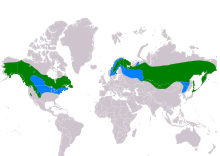Pine grosbeak
| Pine grosbeak | |
|---|---|

| |
| Male | |

| |
| Female in Canada | |
| Scientific classification | |
| Domain: | Eukaryota |
| Kingdom: | Animalia |
| Phylum: | Chordata |
| Class: | Aves |
| Order: | Passeriformes |
| Family: | Fringillidae |
| Subfamily: | Carduelinae |
| Genus: | Pinicola Vieillot, 1808 |
| Species: | P. enucleator
|
| Binomial name | |
| Pinicola enucleator | |

| |
| Breeding range of P. enucleator Resident Non-breeding
| |
| Synonyms | |
|
Loxia enucleator Linnaeus, 1758 | |
The pine grosbeak (Pinicola enucleator) is a large member of the true
Taxonomy
The pine grosbeak was
The pine grosbeak is a
Eight subspecies are recognised:[5]
- P. e. enucleator (Linnaeus, 1758) – Scandinavia to central Siberia
- P. e. kamtschatkensis (Dybowski, 1883) – northeastern Siberia
- P. e. sakhalinensis Buturlin, 1915 – Sakhalin and the Kuril Islands, northern Japan
- P. e. flammula Homeyer, 1880 – coastal southern Alaska and western Canada
- P. e. carlottae Brooks, AC, 1922 – the Queen Charlotte Islands (off western Canada)
- P. e. montana Ridgway, 1898 – inland southwestern Canada to west-central U.S.
- P. e. californica Price, 1897 – eastern California
- P. e. leucura (Müller, PLS, 1776) – inland west, central Alaska to eastern Canada and northern New England (U.S.)
Description
This species is one of the largest species in the
Its voice is geographically variable, and includes a whistled pui pui pui or chii-vli. The song is a short musical warble.
Distribution and habitat

Pine grosbeaks breed in the boreal forests of northern Eurasia and North America, and typically either remain resident near their breeding grounds or migrate relatively short distances to the southern extent of boreal forests. During irruptive years, more travel to southern boreal forests and some move further south. In such years in the New World, they can occur well south of their typical winter distribution, which is the northern
Behaviour and ecology
The breeding habitat of the pine grosbeak is coniferous forests. They nest on a horizontal branch or in a fork of a conifer. This bird is a permanent resident through most of its range; in the extreme north or when food sources are scarce, they may migrate farther south. When breeding both sexes develop gular pouches which they use to store seeds before feeding them to the young.[14]
Pine grosbeaks forage in trees and bushes. They mainly eat seeds, buds, berries, and insects. Outside of the nesting season, they often feed in flocks.
-
Immature male
-
Front view of female, notice forked tail, Gatineau Park, Quebec
-
Eggs of Pinicola enucleatorMHNT
References
- . Retrieved 11 November 2021.
- ^ Linnaeus, Carl (1758). Systema Naturae per regna tria naturae, secundum classes, ordines, genera, species, cum characteribus, differentiis, synonymis, locis (in Latin). Vol. 1 (10th ed.). Holmiae (Stockholm): Laurentii Salvii. p. 171.
- ^ Paynter, Raymond A. Jr, ed. (1968). Check-List of Birds of the World. Vol. 14. Cambridge, Massachusetts: Museum of Comparative Zoology. p. 284.
- ^ Vieillot, Louis Pierre (1807). Histoire naturelle des oiseaux de l'Amérique Septentrionale : contenant un grand nombre d'espèces décrites ou figurées pour la première fois (in French). Vol. 1. Paris: Chez Desray. p. iv. The volume is dated 1807 on the title page but was not published until the following year.
- ^ Rasmussen, Pamela, eds. (2020). "Finches, euphonias". IOC World Bird List Version 10.1. International Ornithologists' Union. Retrieved 21 April 2020.
- ISBN 978-1-4081-2501-4.
- ^ PMID 22023825.
- .
- ^ "Pine Grosbeak Identification, All About Birds, Cornell Lab of Ornithology". www.allaboutbirds.org. Retrieved 2020-09-29.
- ISBN 978-0-8493-4258-5.
- ISBN 0-691-03424-9.
- ^ Adkisson, C. S. (1999). "Pine grosbeak (Pinicola enucleator)". In Poole, A. (ed.). The Birds of North America Online. Ithaca: Cornell Lab of Ornithology.
- ^ Töpfer, Till (2007). "Nachweise seltener Vogeltaxa (Aves) in Sachsen aus der ornithologischen Sammlung des Museums für Tierkunde Dresden" [Records of rare bird taxa (Aves) in Saxony from the ornithological collection of the Zoological Museum Dresden] (PDF). Faunistische Abhandlungen (in German). 26 (3): 63–101.[permanent dead link]
- JSTOR 1364663.
External links
- "Pine grosbeak media". Internet Bird Collection.
- Pine Grosbeak – Pinicola enucleator – USGS Patuxent Bird Identification InfoCenter
- Xeno-canto: audio recordings of the pine grosbeak
- Pine grosbeak photo gallery at VIREO (Drexel University)




